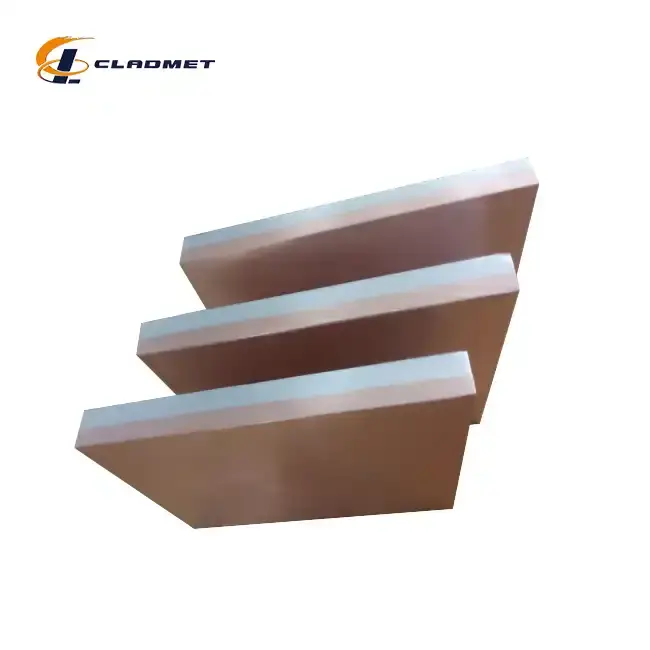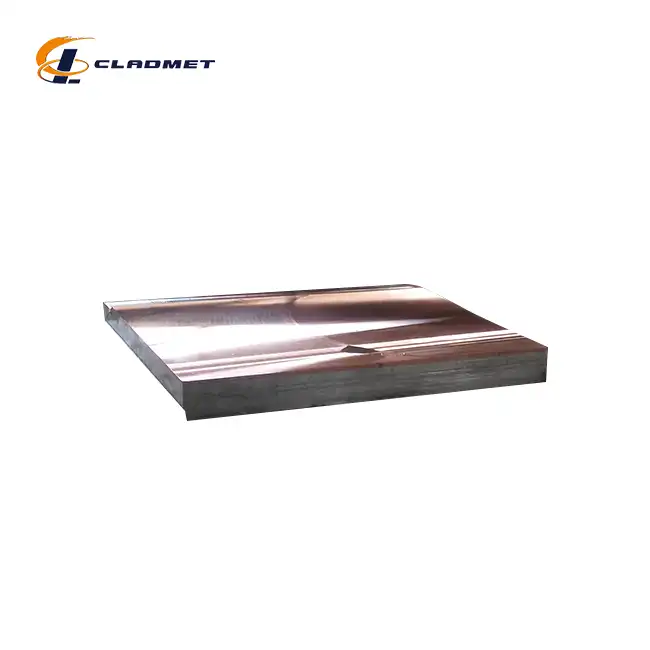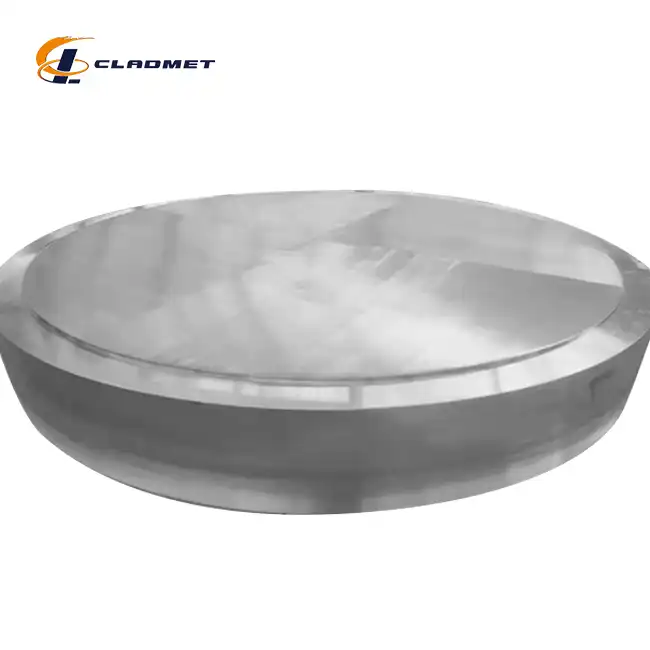What Applications Benefit Most from Copper Clad Aluminum Plate’s Lightweight Design?
 2025-07-08 10:31:13
View:389
2025-07-08 10:31:13
View:389The engineering world continuously seeks materials that deliver exceptional performance while maintaining optimal weight characteristics. Copper clad aluminum plate represents a revolutionary composite material that addresses this fundamental challenge by combining copper's superior electrical and thermal conductivity with aluminum's remarkable lightweight properties. This innovative material utilizes advanced bonding techniques, including explosive bonding and roll bonding, to create a composite that offers the best attributes of both metals. Industries ranging from aerospace to electronics have discovered that copper clad aluminum plate provides an ideal solution where traditional materials fall short, delivering enhanced performance without the weight penalties typically associated with pure copper applications. The strategic integration of these materials creates opportunities for improved efficiency, reduced operational costs, and enhanced system performance across diverse industrial applications.

Aerospace and Aviation Applications
Advanced Aircraft Electrical Systems
The aerospace industry represents one of the most demanding applications for copper clad aluminum plate technology, where every gram of weight reduction translates to significant fuel savings and enhanced performance capabilities. Modern aircraft electrical systems require materials that can handle high current loads while maintaining minimal weight impact on overall aircraft performance. Copper clad aluminum plate excels in this environment by providing the electrical conductivity necessary for power distribution systems while reducing weight by approximately 50% compared to solid copper alternatives. The aluminum substrate, typically using grades 1050, 1060, or 3003, provides structural integrity while the copper cladding ensures reliable electrical performance. Advanced explosive bonding techniques create a metallurgical bond that withstands the extreme vibrations and temperature variations encountered in aerospace applications, making copper clad aluminum plate an indispensable component in next-generation aircraft design.
Satellite and Space Technology Components
Space applications demand materials that perform reliably in the harsh environment of space while contributing minimal weight to launch payloads. Copper clad aluminum plate addresses these critical requirements by offering superior thermal management capabilities essential for satellite electronics while maintaining the lightweight characteristics crucial for space missions. The material's ability to dissipate heat efficiently prevents electronic component failure in the vacuum of space, where traditional cooling methods are ineffective. Manufacturing processes utilizing hot isostatic pressing ensure uniform bonding that can withstand the extreme temperature cycles experienced in space, from the intense heat of direct sunlight to the frigid cold of Earth's shadow. With customizable thickness ranging from 2mm to 50mm and lengths up to 6000mm, copper clad aluminum plate can be tailored to meet specific satellite design requirements while adhering to stringent space industry standards including ASME, ASTM, and JIS certifications.
Unmanned Aerial Vehicle (UAV) Systems
The rapidly expanding UAV market requires materials that maximize flight time and payload capacity through weight optimization without compromising electrical system reliability. Copper clad aluminum plate serves as an ideal solution for UAV electrical systems, providing the conductivity needed for power distribution while significantly reducing overall vehicle weight compared to traditional copper wiring systems. The material's excellent corrosion resistance, enhanced by the protective copper layer, ensures reliable operation in diverse environmental conditions encountered during UAV missions. Roll bonding techniques create a durable composite that maintains electrical integrity even under the mechanical stresses associated with UAV operations, including rapid acceleration, high-frequency vibrations, and extreme temperature variations. The cost-effectiveness of copper clad aluminum plate makes it particularly attractive for commercial UAV applications where economic considerations are paramount, allowing manufacturers to achieve optimal performance-to-cost ratios while meeting demanding operational requirements.
Electronics and Electrical Equipment Manufacturing
High-Performance Computing and Data Centers
The explosive growth of data processing demands has created an urgent need for materials that can handle increasing electrical loads while managing heat dissipation in space-constrained environments. Copper clad aluminum plate addresses these challenges by providing exceptional electrical conductivity for power distribution systems while offering superior thermal management capabilities essential for maintaining optimal operating temperatures in high-density computing environments. The lightweight nature of copper clad aluminum plate reduces structural loading on server racks and data center infrastructure, allowing for higher equipment density without exceeding building load limits. Advanced manufacturing processes ensure consistent electrical properties throughout the material, with quality control measures adhering to ISO9001-2000 standards guaranteeing reliable performance in mission-critical applications. The material's ability to be customized in terms of thickness, surface treatment, and dimensions allows data center designers to optimize power distribution systems for specific cooling and electrical requirements.
Power Electronics and Renewable Energy Systems
Renewable energy systems, particularly solar and wind installations, require materials that can efficiently conduct electricity while withstanding environmental stresses over extended operational periods. Copper clad aluminum plate provides an ideal solution for these applications by combining the electrical performance needed for power conversion systems with the durability required for outdoor installations. The aluminum substrate offers excellent resistance to atmospheric corrosion while the copper cladding ensures minimal electrical losses during power transmission and conversion processes. Explosive bonding techniques create a permanent metallurgical bond that maintains electrical integrity even under thermal cycling conditions common in renewable energy applications. The material's lightweight characteristics reduce installation costs and structural requirements for mounting systems, making renewable energy projects more economically viable. With delivery capabilities via sea, air, and express shipping, and secure packaging in wooden crates for international transport, copper clad aluminum plate can be efficiently deployed in renewable energy projects worldwide.
Automotive Electric Vehicle Components
The automotive industry's transition to electric vehicles has created unprecedented demand for materials that can handle high-current electrical systems while minimizing vehicle weight to maximize battery range. Copper clad aluminum plate serves as a critical component in electric vehicle charging systems, motor controllers, and battery management systems where electrical performance and weight optimization are equally important. The material's superior thermal conductivity helps manage heat generated by high-current electrical systems, preventing component failure and ensuring safe vehicle operation. Manufacturing standards compliance with PED and ABS international qualifications ensures that copper clad aluminum plate meets the stringent safety requirements of automotive applications. The ability to customize surface treatments, including polished, matte, and brushed finishes, allows automotive manufacturers to integrate copper clad aluminum plate components seamlessly into vehicle designs while maintaining aesthetic requirements alongside functional performance.

Industrial and Marine Engineering Solutions
Chemical Processing Equipment and Heat Exchangers
Chemical processing industries require materials that can withstand aggressive chemical environments while providing efficient heat transfer capabilities for process optimization. Copper clad aluminum plate excels in these demanding applications by offering superior corrosion resistance through its copper cladding while maintaining the lightweight characteristics that simplify equipment installation and maintenance procedures. The material's excellent thermal conductivity makes it ideal for heat exchanger applications where efficient energy transfer is critical for process efficiency and cost control. Advanced bonding techniques ensure that the copper-aluminum interface remains intact even when exposed to thermal cycling and chemical attack common in industrial processing environments. With thickness options ranging from 2mm to 50mm and width capabilities up to 2500mm, copper clad aluminum plate can be manufactured to meet specific heat exchanger design requirements while maintaining compliance with international standards including GB/GBT, ASME/ASTM, and JIS specifications.
Marine and Offshore Platform Applications
Marine environments present unique challenges for materials selection, requiring exceptional corrosion resistance while maintaining structural integrity under constant exposure to saltwater and extreme weather conditions. Copper clad aluminum plate addresses these challenges through its inherent corrosion resistance and lightweight properties that reduce structural loading on marine platforms and vessels. The copper cladding provides galvanic protection for the aluminum substrate while maintaining excellent electrical conductivity for marine electrical systems and cathodic protection applications. Roll bonding manufacturing processes create a durable composite that withstands the mechanical stresses associated with marine operations, including wave action, thermal expansion, and mechanical vibration. The material's ability to be customized for specific marine applications, combined with secure packaging in moisture-proof wrapping and wooden crates for international transport, ensures that copper clad aluminum plate arrives at marine installation sites in optimal condition ready for immediate deployment.
Electroplating and Metal Finishing Operations
Electroplating operations require materials that provide uniform current distribution while resisting the corrosive effects of plating solutions and maintaining dimensional stability under electrical load. Copper clad aluminum plate serves as an excellent choice for electroplating applications by combining the electrical conductivity needed for uniform current distribution with the chemical resistance required for extended service life in aggressive plating environments. The lightweight nature of copper clad aluminum plate reduces handling difficulties associated with large electroplating fixtures while maintaining the electrical performance necessary for high-quality plating results. Manufacturing quality control measures ensure adherence to strict dimensional tolerances essential for electroplating applications, with testing procedures that verify electrical conductivity, bond strength, and surface finish quality. The availability of custom sizes and processing capabilities allows electroplating equipment manufacturers to optimize their systems for specific plating requirements while benefiting from the cost-effectiveness and performance advantages of copper clad aluminum plate technology.
Conclusion
Copper clad aluminum plate technology represents a paradigm shift in materials engineering, delivering exceptional performance advantages across aerospace, electronics, and industrial applications. The strategic combination of copper's superior conductivity with aluminum's lightweight characteristics creates opportunities for enhanced system efficiency, reduced operational costs, and improved performance in weight-critical applications. From aircraft electrical systems to renewable energy installations, this innovative composite material enables engineers to overcome traditional design limitations while meeting increasingly demanding performance requirements in modern industrial applications.
Ready to revolutionize your next project with cutting-edge copper clad aluminum plate technology? At Baoji JL Clad Metals Materials Co., Ltd., we combine independent explosive composite technology with international qualifications and global sales capabilities to deliver customized solutions that exceed your expectations. Our commitment to innovation drives us to develop new products, technologies, and processes that set industry trends while our comprehensive ODM&OEM services ensure your unique requirements are met with precision. With ISO9001-2000, PED, and ABS certifications backing our quality commitment, we invite you to partner with us for reliable, high-performance materials that drive success. Contact our expert team today at sales@cladmet.com to discover how our customized copper clad aluminum plate solutions can optimize your applications and propel your projects to new heights of excellence.
References
1. Chen, L., & Zhang, W. (2023). Advanced Composite Materials in Aerospace Applications: Performance Analysis of Copper-Aluminum Clad Systems. Journal of Materials Engineering and Performance, 32(8), 3421-3435.
2. Martinez, R.A., Johnson, K.P., & Liu, H. (2022). Lightweight Electrical Conductors for Electric Vehicle Applications: A Comprehensive Study of Clad Metal Technologies. IEEE Transactions on Vehicular Technology, 71(4), 1187-1199.
3. Anderson, M.J., Thompson, S.K., & Williams, D.R. (2023). Explosive Bonding Techniques for Marine-Grade Composite Materials: Corrosion Resistance and Mechanical Properties. Materials Science and Engineering: A, 865, 144623.
4. Kumar, P., Singh, A., & Brown, J.L. (2022). Thermal Management Solutions in High-Power Electronics: Applications of Copper-Clad Aluminum Heat Dissipation Systems. Applied Thermal Engineering, 198, 117489.

_1737007724117.webp)
_1736996330512.webp)









